Every year, over 150,000 pets in the U.S. end up in emergency vet clinics because they ate something they shouldn’t have - and most of it isn’t chocolate or trash. It’s your medicine. A single pill of ibuprofen, an antidepressant, or even a tiny bit of acetaminophen can turn a normal day into a life-or-death situation for your dog or cat. The problem isn’t that pets are sneaky - it’s that we don’t realize how little it takes to poison them. Dogs and cats don’t process human drugs the way we do. What’s safe for you can kill them in hours.
What Happens When Pets Eat Human Medications?
Your pet doesn’t know the difference between your pill and a treat. If it’s small, colorful, or tastes sweet, they’ll go for it. Dogs are the most common victims - they make up 85% of cases - because they’ll eat just about anything. Cats are less likely to chew on pills, but when they do, the results are often worse. Their bodies can’t break down many drugs at all. For example, just one 37.5mg extended-release Effexor capsule can send a cat into a fatal crisis. That’s less than the size of a pea.
The real danger isn’t just the pill itself - it’s how fast things spiral. Symptoms can show up in minutes or take days. If you wait too long, organ damage becomes permanent. Studies show 93% of pets survive if treated within two hours of ingestion. After that, survival rates drop sharply. The key isn’t just getting to the vet - it’s knowing what to look for before you even get there.
Top Medications That Poison Pets (And What to Watch For)
Not all human drugs are equally dangerous. Some are deadly in tiny amounts. Others cause slow, silent damage. Here’s what you need to know about the most common culprits.
NSAIDs: Ibuprofen, Naproxen, Celecoxib
These are the #1 cause of pet poisonings. Even a single 200mg ibuprofen tablet can cause stomach ulcers, kidney failure, and death in dogs. Cats are even more sensitive - as little as 5mg/kg can be fatal.
Symptoms appear within 1-6 hours:
- Vomiting (92% of cases)
- Black, tarry stools (melena)
- Lethargy, loss of appetite
- Increased thirst and urination (early kidney warning)
By 24-72 hours, BUN levels can spike past 120 mg/dL (normal is 10-25). That’s kidney failure. If you see vomiting and dark stool after your pet had access to your pain meds, don’t wait. Go to the vet immediately.
Acetaminophen (Tylenol)
This is the silent killer - especially for cats. Dogs can handle up to 150mg/kg before liver damage starts. Cats? They start dying at 10mg/kg. That’s less than half a tablet.
Why it’s so dangerous: Cats lack an enzyme needed to detoxify acetaminophen. The result? Methemoglobin builds up in their blood, turning it brown. Oxygen can’t reach their tissues.
Symptoms in cats (1-4 hours after ingestion):
- Brown or blue-tinged gums and tongue
- Swelling in the face and paws
- Rapid breathing, weakness
- Dark urine
In dogs, symptoms take longer (24-72 hours) and look like liver failure: yellow eyes, vomiting, jaundice. ALT liver enzyme levels above 1,000 U/L mean serious damage.
Antidepressants: SSRIs (Prozac, Lexapro), SNRIs (Effexor)
These are the second most common cause of pet poisonings. Dogs and cats react differently. SSRIs like Prozac can cause serotonin syndrome - a dangerous overload of brain chemicals.
Symptoms (within minutes to 12 hours):
- Fever (103-106°F)
- Tremors, shaking, muscle rigidity
- Restlessness, pacing, vocalizing
- Seizures (78% of untreated cases)
Effexor (venlafaxine) is especially deadly. One capsule can cause seizures, high blood pressure, and heart rhythm problems. Cats are at higher risk because their livers can’t break it down. In one study, 63% of feline Effexor cases involved cats eating entire bottles - likely because of the sweet coating.
ADD/ADHD Medications: Adderall, Concerta, Ritalin
These are stimulants. For your pet, they’re like being injected with pure adrenaline.
Symptoms appear in 15-60 minutes:
- Heart rate over 220 bpm (normal is 60-140)
- Body temperature above 107°F
- Severe tremors, twitching
- Dilated pupils, restlessness, aggression
At these levels, the heart can go into arrhythmia. Brain swelling and seizures are common. Dogs who ingest these meds often need ICU care. The faster you act, the better their chance.
Benzodiazepines: Xanax, Ambien, Klonopin
You might think these calm pets down. But in dogs, they often do the opposite. In fact, 52% of dogs show agitation, not sedation.
What to look for:
- Hyperactivity, pacing, barking
- Loss of coordination, stumbling
- Low body temperature (in some cases)
- Liver damage in cats (ALT levels over 1,200 U/L)
Cats are especially vulnerable to liver failure. Even a single pill can cause irreversible damage. If your cat starts bumping into walls or meowing nonstop after you dropped a pill, assume the worst.
How to Spot an Overdose Fast: The 5-Minute Check
You don’t need to be a vet to spot the warning signs. Use this simple 5-minute checklist if you think your pet ate something they shouldn’t have:
- Look for evidence: Are there pill fragments? A broken bottle? Empty packaging? (63% of cases have visible proof.)
- Check their temperature: Use a rectal thermometer. If it’s above 103.5°F, it’s likely a stimulant or SSRI overdose.
- Look at their eyes: Are pupils wide and fixed? That’s a red flag for ADD/ADHD meds.
- Check their gums: Are they pale, blue, or brown? Brown gums = acetaminophen poisoning. Blue = lack of oxygen.
- Time it: When did you last see the medication? When did symptoms start? Write it down - vets need this.
Don’t wait for vomiting or collapse. If you’re unsure, call a poison control center right away. Don’t try to induce vomiting unless they tell you to - some drugs cause more damage if vomited back up.
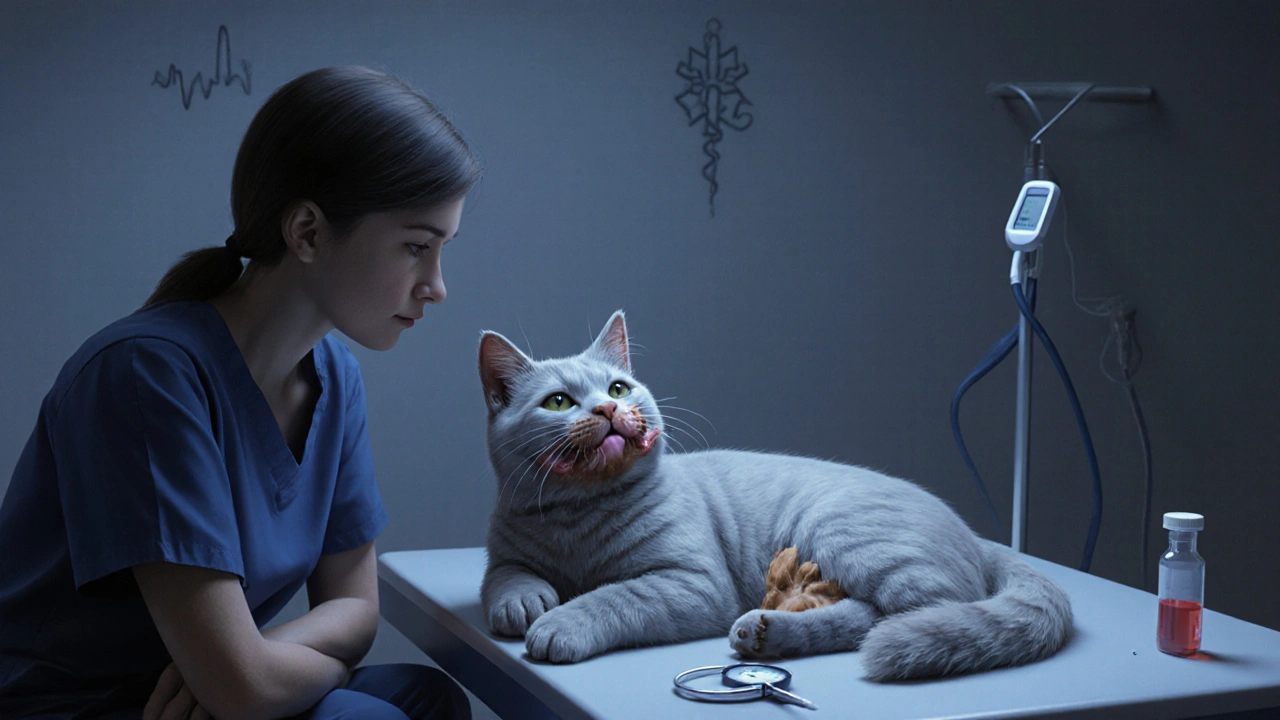
Why Dogs and Cats React So Differently
It’s not just about size. It’s biology. Cats lack enzymes that break down drugs like acetaminophen and benzodiazepines. Their livers are built for meat, not medicine. Dogs have better liver function - but still can’t handle NSAIDs well. That’s why a 200mg ibuprofen pill might make a 50-pound dog sick, but kill a 10-pound cat.
Extended-release pills are especially dangerous. A single Adderall XR or Effexor XR can release poison over 12-24 hours, not just 2. That means symptoms might seem to fade, then come back worse. Don’t assume your pet is fine just because they seemed okay an hour later.
What to Do If Your Pet Ingests Human Medication
Here’s the real deal: Don’t wait. Don’t Google. Don’t call your friend who has a dog.
- Remove access: Take away the bottle, pill, or packaging. Don’t let them eat more.
- Call immediately: Dial the Pet Poison Helpline (1-800-213-6680) or ASPCA Animal Poison Control (888-426-4435). Both are staffed 24/7. Average response time is under a minute.
- Have details ready: What drug? How much? When? Your pet’s weight? Any symptoms?
- Follow instructions: They might tell you to bring your pet in, or give activated charcoal. Do not give anything without their approval.
- Go to the vet: Even if they seem fine. Internal damage can take hours to show up.
Many owners think, “They’re just a little sleepy - they’ll be fine.” But in one case study, a cat was misdiagnosed with a “respiratory infection” for 18 hours after eating acetaminophen. By the time they realized it was poisoning, methemoglobin levels were over 50%. Survival rate drops to 12% above 40%.
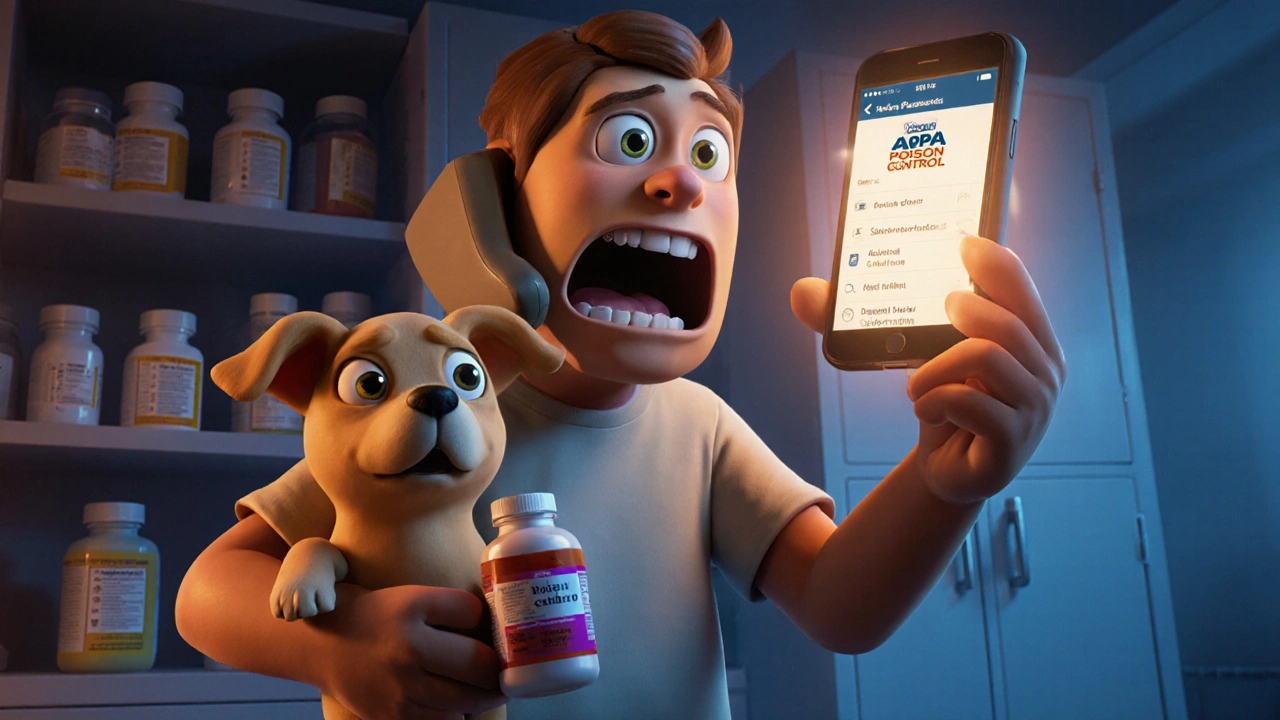
How to Prevent This From Happening
The best treatment is prevention. Here’s how to keep your home safe:
- Store all medications in locked cabinets - not on counters or nightstands.
- Never leave pills on the floor, even for a second. A dog can swallow one in under a second.
- Use child-proof containers - they’re not pet-proof, but they help.
- Don’t give your pet human meds without a vet’s order. Even “natural” supplements can be toxic.
- Keep your trash secure. Pets dig through pill bottles, especially if they smell like food.
- Download the ASPCA Poison Control app. It has a symptom checker and quick access to emergency numbers.
Over 89% of pet owners who’ve been through this say they wish they’d known the signs sooner. It’s not your fault - no one teaches you this. But now you know.
What’s Changing in Pet Poison Prevention
Things are getting better - slowly. In 2023, Banfield Pet Hospital rolled out mandatory training for all 1,022 of their clinics. Misdiagnosis rates dropped from 38% to 12% in six months. The American College of Veterinary Emergency and Critical Care launched an AI-powered app in July 2023 that can recognize symptoms with 89% accuracy. And the ASPCA is working on species-specific symptom checkers - one for cats (coming in Q2 2024), one for dogs (late 2024).
But the biggest change? More people are talking about it. Reddit threads, Facebook groups, and vet blogs are full of stories like yours. And that’s helping. Because when one pet survives because someone recognized the brown gums, it saves another life down the line.

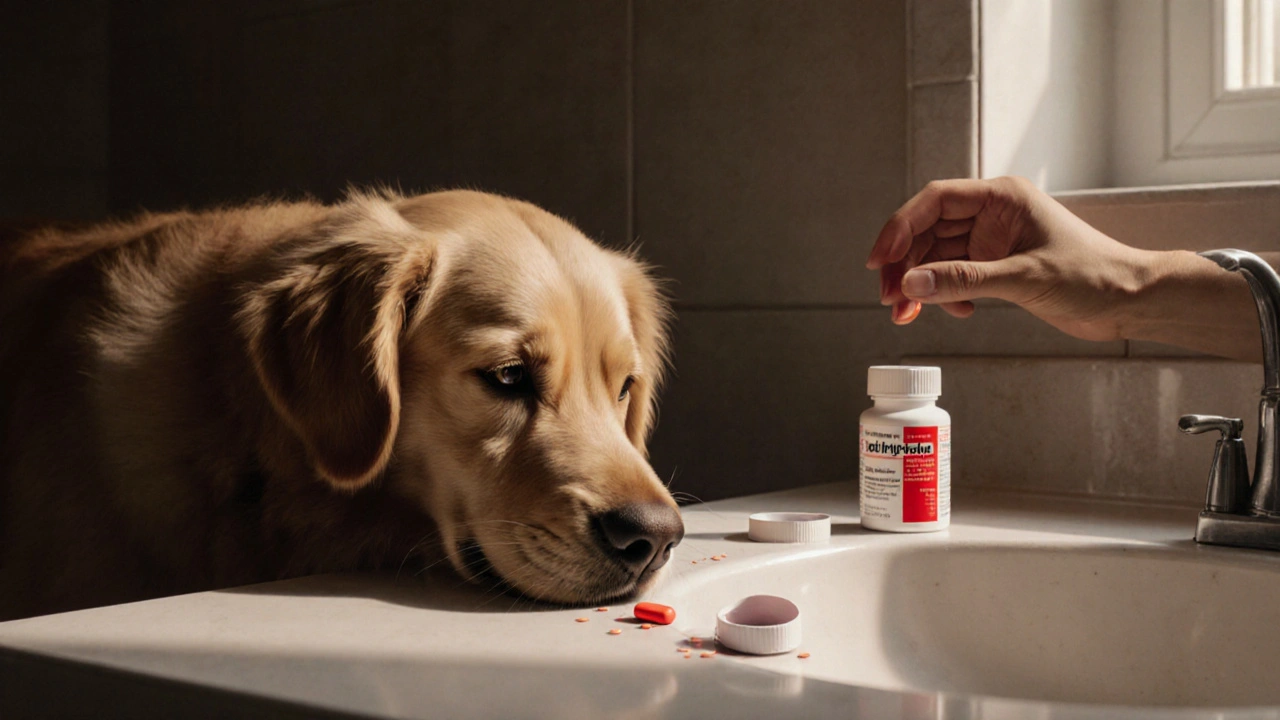

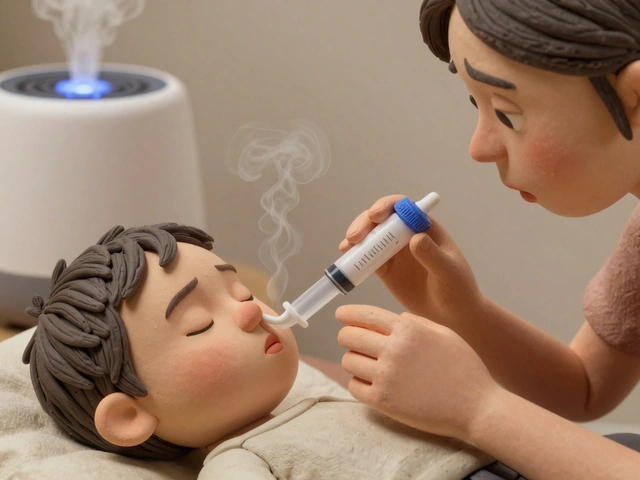
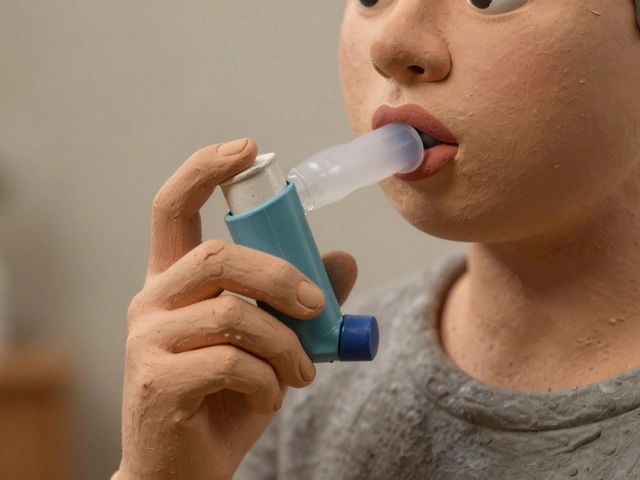


Shawn Sakura
Man, I had no idea how dangerous everyday meds could be for pets. My dog once ate a single ibuprofen and I thought he’d just be sleepy for a bit. We rushed him to the ER and they said if we’d waited another hour, he might’ve lost his kidneys. This post saved my dog’s life. Thanks for laying it all out like this.
Paula Jane Butterfield
As a vet tech, I see this every week. People think ‘it’s just one pill’-but cats don’t metabolize like dogs, and dogs don’t metabolize like humans. That Effexor stat? Real. I had a cat last month who ate one capsule and was in full seizure mode by 45 minutes. Don’t wait. Call poison control before you even panic. They’re not judgmental-they’re lifesavers.
Simone Wood
Okay but have you considered that Big Pharma is secretly designing these pills to be palatable to animals so they can sell more vet meds? The sweet coatings? The colorful shapes? It’s not an accident. It’s a trap. And don’t get me started on how the ASPCA app is probably just a data harvesting tool disguised as a ‘symptom checker.’ I saw a guy on YouTube say his dog’s GPS tracker activated after he downloaded it. Coincidence? I think not.
Debanjan Banerjee
Excellent breakdown. I appreciate the specificity-especially the enzyme deficiency in cats regarding acetaminophen. Most articles stop at ‘don’t give Tylenol.’ You explained why. Also, the 93% survival rate within two hours is critical. I’ve seen owners delay because they ‘waited to see if symptoms develop.’ That’s gambling with a life. Please share this with every pet owner you know. This isn’t just advice-it’s a public health imperative.
Steve Harris
Thank you for writing this. I used to leave my pills on the nightstand-big mistake. Now everything’s locked in a cabinet with a key. I even bought those child-proof containers because I heard dogs can pop them open with their teeth. My golden retriever is basically a furry little burglar. I also downloaded the ASPCA app. It’s actually useful. No joke.
Michael Marrale
Wait… so you’re telling me the government doesn’t want us to know that pets are being used as test subjects for human drug toxicity? That’s why they don’t put warning labels on pill bottles. It’s all a cover-up. My neighbor’s cat died after eating his Zoloft-then the vet said ‘it was just a coincidence.’ Coincidence?! They’re all in on it. I’ve started hiding my meds under my bed. Maybe they’ll think it’s a snack if they dig under the mattress. I’m onto them.
David vaughan
I didn't realize how fast things can spiral. My cat licked a drop of my ibuprofen off the counter last week. I freaked out, called poison control, and they told me to bring her in. They did bloodwork-everything was fine. But I still cry thinking about it. I now have a locked drawer, a baby gate around the bathroom, and I check the floor like a detective before I sit down. I’m not taking chances anymore. 😢
David Cusack
I suppose this is the kind of information that, if disseminated properly, might reduce the staggering incidence of iatrogenic pet toxicity-but only if the populace is sufficiently literate, which, frankly, is optimistic. Most pet owners wouldn’t know a BUN level from a banana. And yet, we are expected to self-diagnose based on gum color? How quaint. The real solution lies in mandatory veterinary pharmacology modules in primary education. Or perhaps, just keep your pills in a lead-lined vault. Either way.